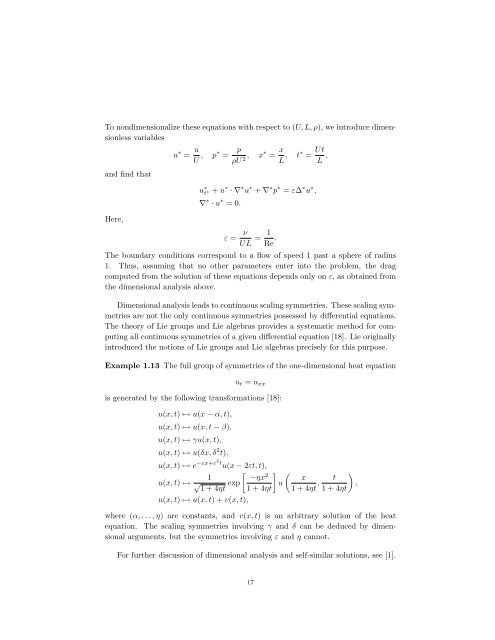Asymptotic Analysis and Singular Perturbation Theory
Asymptotic Analysis and Singular Perturbation Theory
Asymptotic Analysis and Singular Perturbation Theory
You also want an ePaper? Increase the reach of your titles
YUMPU automatically turns print PDFs into web optimized ePapers that Google loves.
To nondimensionalize these equations with respect to (U, L, ρ), we introduce dimensionless<br />
variables<br />
<strong>and</strong> find that<br />
Here,<br />
u ∗ = u<br />
U , p∗ = p<br />
ρU 2 , x∗ = x<br />
L , t∗ = Ut<br />
L ,<br />
u ∗ t ∗ + u∗ · ∇ ∗ u ∗ + ∇ ∗ p ∗ = ε∆ ∗ u ∗ ,<br />
∇ ∗ · u ∗ = 0.<br />
ε = ν 1<br />
=<br />
UL Re .<br />
The boundary conditions correspond to a flow of speed 1 past a sphere of radius<br />
1. Thus, assuming that no other parameters enter into the problem, the drag<br />
computed from the solution of these equations depends only on ε, as obtained from<br />
the dimensional analysis above.<br />
Dimensional analysis leads to continuous scaling symmetries. These scaling symmetries<br />
are not the only continuous symmetries possessed by differential equations.<br />
The theory of Lie groups <strong>and</strong> Lie algebras provides a systematic method for computing<br />
all continuous symmetries of a given differential equation [18]. Lie originally<br />
introduced the notions of Lie groups <strong>and</strong> Lie algebras precisely for this purpose.<br />
Example 1.13 The full group of symmetries of the one-dimensional heat equation<br />
ut = uxx<br />
is generated by the following transformations [18]:<br />
u(x, t) ↦→ u(x − α, t),<br />
u(x, t) ↦→ u(x, t − β),<br />
u(x, t) ↦→ γu(x, t),<br />
u(x, t) ↦→ u(δx, δ 2 t),<br />
u(x, t) ↦→ e −εx+ε2 t u(x − 2εt, t),<br />
2<br />
1 −ηx x<br />
u(x, t) ↦→ √ exp u<br />
1 + 4ηt 1 + 4ηt 1 + 4ηt ,<br />
<br />
t<br />
,<br />
1 + 4ηt<br />
u(x, t) ↦→ u(x, t) + v(x, t),<br />
where (α, . . . , η) are constants, <strong>and</strong> v(x, t) is an arbitrary solution of the heat<br />
equation. The scaling symmetries involving γ <strong>and</strong> δ can be deduced by dimensional<br />
arguments, but the symmetries involving ε <strong>and</strong> η cannot.<br />
For further discussion of dimensional analysis <strong>and</strong> self-similar solutions, see [1].<br />
17
















